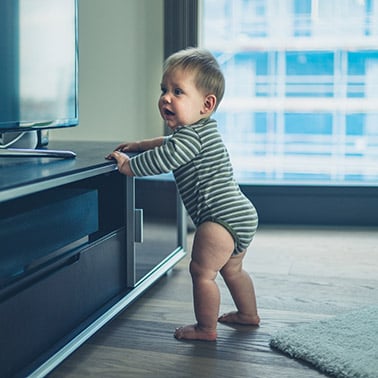Life’s about to change (again). Your little one is on the move, they’re lifting themselves and taking the first step on the path to walking. This is baby cruising—and it means you need to get your house in order.
What does baby cruising mean?
No, it’s not a luxury family boat trip, a new way to drive or a dance move. The term ‘baby cruising’ is used to describe the stage between crawling or ‘bottom shuffling’ and walking independently. A baby is ‘cruising’ when they walk holding onto furniture, like a sofa or coffee table.
At what age do babies pull themselves up and start cruising?
Baby cruising happens around the same time as your baby pulling themselves up: some time around the 8-12 months mark. Some babies crawl long before they cruise, but not all do. Don’t worry if yours doesn’t—your little one will reach this special moment in their own time.
How to support your baby when they start cruising
Try encouraging them to walk by supporting them with your hands under their arms and giving them a gentle bounce. You may find they enjoy this feeling so much they try to stay upright by straightening their legs, or even resist being put back down.
Going from sitting to standing for the first time is a massive achievement. Your baby may call for help because they don’t know how to get back down. You can help them learn by pushing them gently back onto their bottom. It won’t take them long to work it out for themselves. Encourage your baby to pull themselves up by putting a favourite toy just out of reach on a sofa or a low table.
If your baby has their feet at an angle when they first start cruising, it’s quite normal. This can happen while the muscles in their legs are developing. However, if this continues or you have worries about it, ask your GP for advice.
What are the stages of baby cruising?
Although there are no hard deadlines to their development, here’s an outline of what to expect:
Newborn to two months
Your baby will already be displaying the instincts needed to walk. If they feel a surface under their feet, you might notice them bracing against it.
Five to ten months
At around six months, your baby will take their own weight if you help them. They’ll likely be bouncing up and down with their feet on your thighs with you supporting them. During this phase, your baby might learn to sit, roll over and possibly crawl - activities that will help them develop strength and confidence.
Seven months to one year
In this phase, your baby will probably develop the ability to pull themselves up from a sitting to a standing position using furniture (or a convenient leg) for support. They won’t cruise straight away, in fact, it’s more likely they’ll come back down with a bump! As their balance and confidence develops, your baby will start to cruise - tentatively at first, but before long their mobility will improve.
One year onwards
How long it takes for babies to walk after cruising depends entirely on the individual. The progression from baby cruising to walking isn’t always a quick one. Although we take it for granted, walking is a complicated business, demanding significant strength, balance and coordination.
Get ready for the next step on their journey
As their confidence grows, you’ll need to be more alert, keeping hot drinks and other potentially harmful objects out of reach. There will be the occasional slip or bump along the way, but you can minimise these by baby-proofing your home.


 your parenting partner
your parenting partner